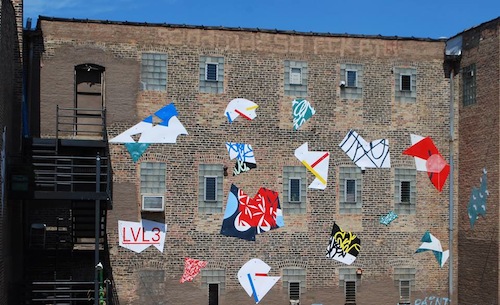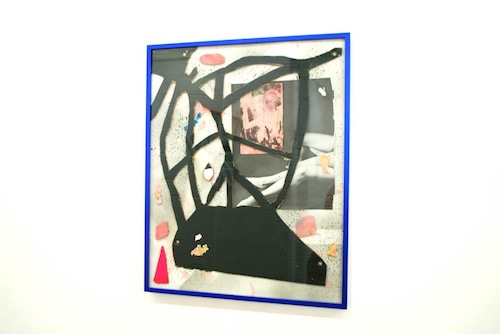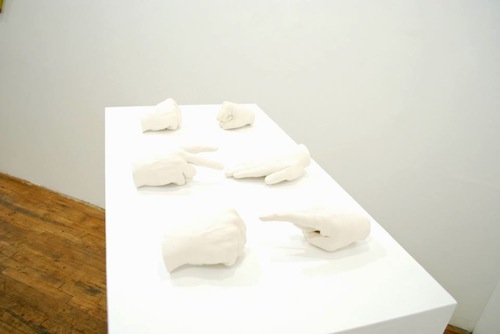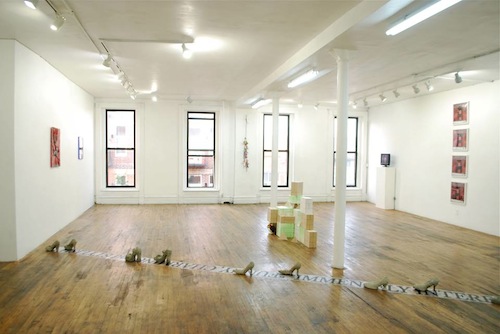
Wyatt Grant/Mike Paro. “LVL3 Assemblage,” 2013. Latex paint, syntra, bolts. 30 x 30 in. Courtesy LVL3.
Lubinski Furniture at 1550 N. Milwaukee Avenue, located in the Wicker Park area of Chicago, has a long history of artist-run spaces. In the last ten years I’ve known a healthy series of disparate ones, from Plasticene Theater (before my time) to Buddy Gallery (once the home of Lumpen magazine), High School, All-rise (a gallery space briefly subsidized by an underground hostel), Enemy, Scott Projects, Cinema Borealis, and Heaven. While the latter two continue to thrive, the same property is presently occupied by newer spaces including TriTriangle, Happy Dog, and LVL3—and yet the artistic energy characteristic of the entire complex endures. It seems fitting then that LVL3 would host a summer show devoted to collaborative relationships, a show whose very premise underscores the fact that rarely, if ever, do artists create in a vacuum.
2 of a Kind platforms eight artist pairs who created new work specifically for the show. The exhibit, the gallery, and the building are indicative of an exciting, often invisible network of relationships, historical and contemporary, pragmatic and idealistic, that facilitate artistic production. LVL3 is located on the third floor of the building. Entering from the street, one walks up a dark flight of stairs, up a second flight of stairs and into LVL3, whose current show represents a nexus of contemporary makers. 2 of a Kind displays a wide range of work in various mediums. The aesthetic is varied but every object affirms a productive partnership. Unlike the faded, all but forgotten relationships that occupied this space in the past, 2 of a Kind is a coeval snap shot of dualistic artistic relationships now.
The work on display feels fast and new, exhilarated by the challenge of itself. Jacob Goudreault and Sofia Leiby’s paintings were allegedly made within one week of the gallery’s opening, just after the artists decided to work together. One diptych, SL JG SD (2013), features abstract brush marks—red, yellow and black on one, the other peach, blue, yellow, red and purple. The varied markings are energetic; paint strokes weave in, out, and over one another, causing foreground and background to flip-flop. Their second painting, SL JG (2013), looks like it has been wrapped and sealed in vacuum-packed fabric. Creases of material bunch into unexpected cracks, disrupting the flat tableau of a traditional picture plane. One might want to peel it back, to see what lies underneath but a crude red box with an irregular shape is painted over the folds, adding a sense of primacy to the surface. Chelsea Culp and Katy Cowan collaborated on a floor piece that stretches diagonally across the gallery floor—a banner of critical text including the phrase “…Immensely interesting and deeply moving…” is positioned beneath several pairs of clunky, cement high heel shoes. The shoes use the banner like a runway, walking over this disembodied, positive statement. Mike Andrews and Andy Jordan composed a wall-mounted tableau of photos, and a video featuring abstract costumes, choreography, and animation—mediums and movement interplay seamlessly. Working as collaborators since 2008, Sarah and Joseph Belknap mounted two dark “Moon Skins” on the wall. Made with silicone and simulated lunar regolith (a material created to simulate the chemical and material properties of grit found on the surface of the moon), they look like black casts of a Michel Gondry moon surface, hanging flat on the wall with deep pock marks. In the middle of the gallery floor Matt Nichols and Josue Pellot installed a variable sculpture of fade-green, tan, and white bricks; on one side, the resulting wall appears to balance on a ceramic piece of dishware. A sense of play lingers in the wall’s composition.

Michael Hunter/Rachel Niffenegger. “Her Peace Shell and Sea Collection,” 2013. Acrylic, spray paint, cardboard, canvas, paper, postcard, book page, cd foil, plaster and studio debris in metal and glass frame. 16.5 x 20.5 in. Courtesy LVL3.
The force of collaboration is not always immediately apparent in the work itself. Much of what is on display seems cleanly composed and singular minded—as evidence that some cohesion took place prior to the works’ completion. In that regard the show feels especially optimistic. Michael Hunter and Rachel Niffenegger created a few paintings and a necklace, for instance, works that show the distinct hand of each artist; Niffenegger’s figurative, macabre, and sometimes humorous sensibility meets Hunter’s rough minimalism. In their collaboration in particular, the back-and-forth of a visual dialogue is evident in the fragments of material and color. While hanging on the wall, Her Peace Shell and Sea Collection (2013) uses a glass picture frame like a vitrine. Layers are built on layers with pictures inside pictures using a variety of mediums, at the base of which is an atmospheric and variant gray background. A bust with a deteriorated and no longer legible face is framed by a set of black and white legs. These lie beneath a set of black spidery lines cut out of cardboard, its shape reminiscent of a window and a ledge or a bird cage on a shelf. Smaller, additional cardboard shapes and “studio debris” pepper the surface. Yet still, the artists’ dynamic, visual discourse congeals into a cohesive picture.

Alan Fleming/Michael Fleming. “Rock Paper Scissors,” 2011. Hydrocal casts. 3 x 36 x 20 in. Courtesy LVL3.
In another example, twins and regular collaborators Alan and Michael Fleming installed a series of hands, Rock, Paper, Scissors (2011), cast in hydrocal in various positions endemic to the game; in so doing, they give voice to playful antagonism, a tension further explored in Wyatt Grant and Mike Paro’s Framed Painting (2013), which refuses to coalesce within a single frame, or lie flat against the wall.
The blue line train runs along the other side of the building, connecting downtown to the O’Hare Airport. When on the train downtown, just before descending below ground, towards the city center, you can see the back wall of LVL3. It used to look like any other building. For this show, however, Grant and Paro designed a public mural for the exterior wall. Fragments of painted and patterned surface are mounted to the side facing the train. Where flanking buildings depict advertisements for neighborhood stores, 1550 Milwaukee features this visual collaboration. The piece engages the material façade, capturing train passengers, and thereby creating a point of access for those outside the gallery. This is a signpost for the neighborhood’s previous spirit, a spirit still present beneath its slickened streets. It’s a reminder that although not instantly recognizable, past endeavors are palpable in the present.
2 of a Kind is on view at LVL3 through July 21, 2013.




